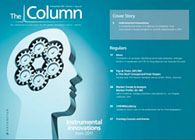CZE assists in drug detection
A novel and rapid capillary zone electrophoresis method has been developed for the rapid simultaneous determination of antimalarial drugs pyrimethamine and sulphadoxine in tablet formulations.
A novel and rapid capillary zone electrophoresis method has been developed for the rapid simultaneous determination of antimalarial drugs pyrimethamine and sulphadoxine in tablet formulations.1
The compounds are separated in 6 min in a fused silica capillary, 30 cm long × 50 µm using a 100 mM phosphate buffer pH 7.2 as background electrolyte, a 330 V cm−1 electric field and a detection wavelength of 214 nm.
Currently, liquid chromatography is used to determine active levels in these drugs, but capillary zone electrophoresis can provide a quicker set up, a shorter run time and low running costs compared with the LC method described in the United States Pharmacopoeia.
The new method could potentially be used to ensure the levels of the active pharmaceutical ingredients in sulphadoxine/pyrimethamine formulations are at the required levels and quality, providing more support for malaria organizations around the world.
1. Amin et al., Journal of Pharmaceutical and Biomedical Analysis, 58, 168-171 (2012).
This story originally appeared in The Column. Click here to view that issue.
Regulatory Deadlines and Supply Chain Challenges Take Center Stage in Nitrosamine Discussion
April 10th 2025During an LCGC International peer exchange, Aloka Srinivasan, Mayank Bhanti, and Amber Burch discussed the regulatory deadlines and supply chain challenges that come with nitrosamine analysis.











